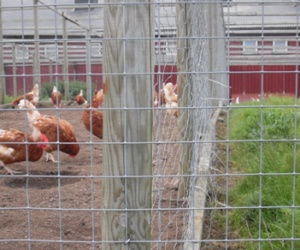Facts:
The studies were financially supported by the Swedish Board of Agriculture and are included in the PhD work of Robin Kalmendal.
included in the PhD work of Robin Kalmendal.

Sunflower cake is an interesting feedstuff for meat-type chickens and laying hens. If the sunflower seed is not dechulled, the cake obtained from oil removal will contain large amounts of water-insoluble fibres. It is believed that these fibres are important to the function of the gastrointestinal tract. Furthermore, sunflower cake contains a relatively large proportion of the amino acid methionine. Methionine is of great importance to poultry but this amino acid is not very abundant in common feed ingredients. In organic production synthetic amino acids are not allowed, wherefore sunflower cake may be of particular interest. Organic poultry must have access to roughage, but how this nutritional component affects the birds is not fully understood.
In spring 2009 a trial with meat-type chickens were set up at the SLU research farm Funbo-Lövsta. Here, some of the results are presented. In addition 600 brown and 600 white layers were stalled in organic conditions; aviaries with access to outdoor runs. Apart from sunflower cake, effects of roughage (lucerne or alfalfa) are studied. These hens are kept until spring 2010 when all practical experiments at Funbo-Lövsta will move to new facilities.

Picture 1. The brown layers rapidly depleted their outdoor run swards and consumed the grass of their white neighbors, whenever they could. (Photo: Robin Kalmendal)
Some of the results obtained are illustrated in tables below. In the meat-type chicken trial the inclusion of hulled sunflower cake was associated with stimulated digestion of protein and fat. The stimulated digestion was mirrored by an increased growth. Compared to the control (0% sunflower cake) feeding 20% sunflower cake resulted in improved growth without adverse effects on feed consumption. Much energy from the feed was derived from the indigestible fibres, wherefore the energy utilisation decreased with sunflower cake inclusion. The birds given sunflower cake had more lactic acid bacteria and less Clostridia in the small intestine, which be regarded as positive.
Table 1. Results from the experiment with meat-type chickens fed hulled sunflower cake
| Feeds, % inclusion of sunflower cake | ||||
| 0 % | 10 % | 20 % | 30 % | |
| Weight difference day 15 to day 31 (kg) | 1.28 | 1.37 | 1.40 | 1.39 |
| Feed utilization from day 15 to day 31 (g/g) | 1.72 | 1.80 | 1.70 | 1.78 |
| Digestion of nutrients | ||||
| Energy | 79 % | 73 % | 70 % | 64 % |
| Protein | 81 % | 81 % | 84 % | 83 % |
| Fat | 87 % | 86 % | 91 % | 91 % |
The preliminary results from the laying hen trial until 40 weeks of age, are shown in table 2. Differences between brown and white hybrids were, as usual, large but these are not presented here. Just a few differences between feeds were statistically different, i.e. not due to randomness. These differences include the scoring of the hen´s plumage, where feeding roughage seems to have reduced damages from feather pecking. Layers fed 26% sunflower cake weighted approximately 100 g less than other birds. This effect is probably reflected in the improved feed utilization seen in white layers fed sunflower cake. So far, no effects on production are seen. Why sunflower cake tends to decrease body weight is to be studied more.
Table 2. Preliminary results from laying hens (40 w. of age) fed sunflower cake or roughage
| Feeds | |||
| Control | Control + Lucerne | 26 % Sunflower cake | |
| Hen weight (kg) | 1.99 | 1.99 | 1.90 |
| Intact plumage at 40 w. | 67 % | 81 % | 69 % |
| Bumble foot score (1 - severe and 5 – no inflammation) | 3.11 | 2.92 | 3.18 |
| Feed consumption (g/day) | 115 | 113 | 113 |
| Feed utilization (kg feed/kg egg) | 2.03 | 2.00 | 1.98 |
| Lay % (n:o eggs/n:o hens and day) | 94 % | 94 % | 95 % |
Another interesting observation was that the brown layers quickly depleted their outdoor run sward by grazing (picture 1), whereas the white layers occupied themselves closely to the stalls.
Helena Wall, helena.wall@slu.se
Robin Kalmendal
Klas Elwinger, Ragnar Tauson and Lena Holm
Doctoral thesis: Fibrous feeds for functional fowls
The studies were financially supported by the Swedish Board of Agriculture and are included in the PhD work of Robin Kalmendal.
included in the PhD work of Robin Kalmendal.